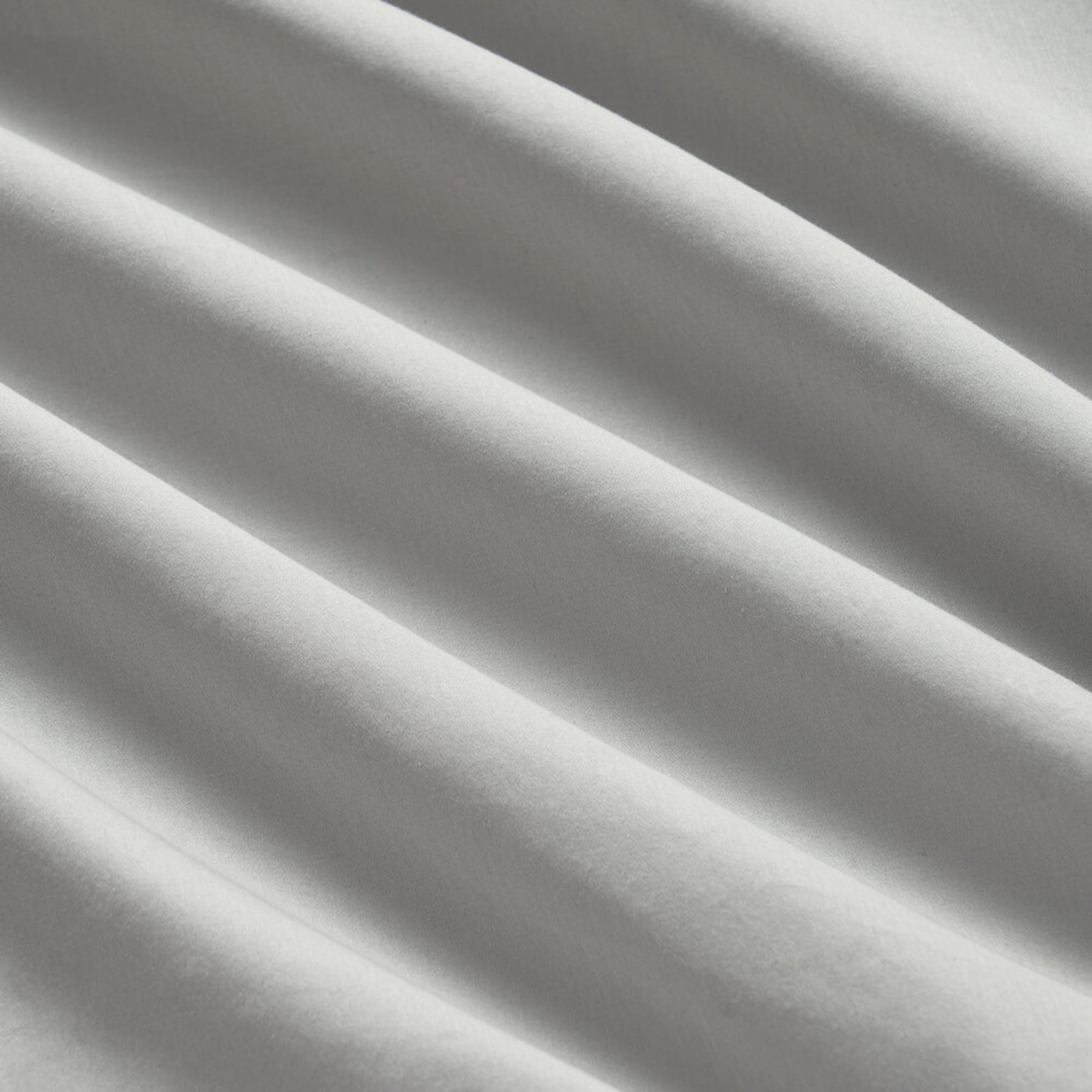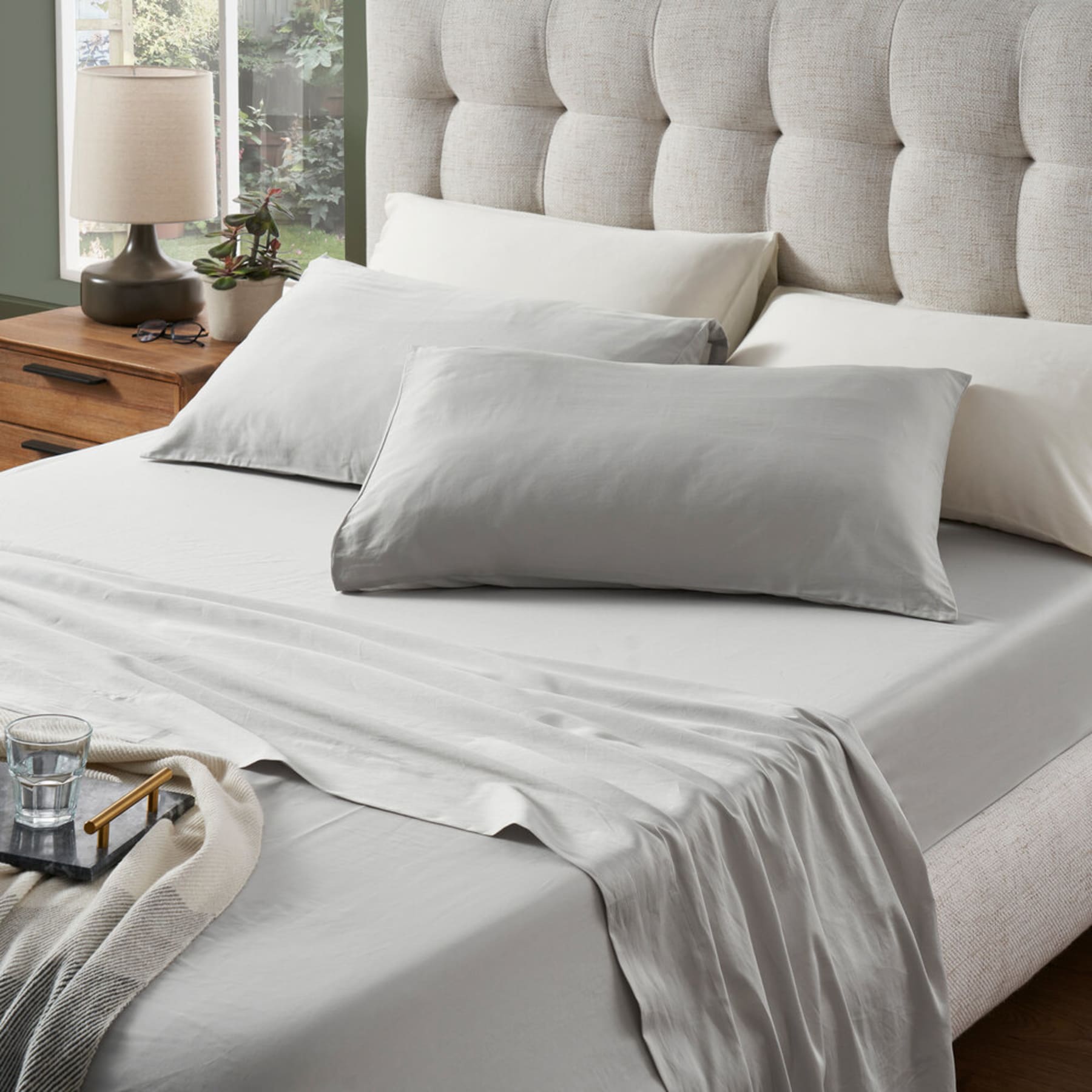
A Comprehensive Guide to Sateen Sheets
Among the many bedding options available, sateen sheets stand out as a symbol of luxury, elegance, and indulgence.
The term "sateen" may sound familiar, but what exactly are sateen sheets? In this comprehensive guide, we will explore the world of sateen sheets, delving into their unique characteristics and benefits.
What is sateen?
Sateen is a weave that creates a luxurious and silky smooth finish. This weave structure involves floating horizontal threads over vertical threads, resulting in a fabric with a glossy surface. The characteristic smoothness and luxurious feel of sateen sheets make them a popular choice for bedding and add an element of elegance to any bedroom.

Sateen has a subtle glossy sheen that makes it luxurious.
Sateen sheets typically have a thread count ranging from 300 to 600. Depending on your personal preferences and also the manufacturer, a higher thread count means the sheets will be denser and heavier.
Sateen vs satin sheets
Sateen and satin are often mistaken for one another, but they are not the same. Sateen and satin are both weave patterns that give bed sheets a glossy shine and luxurious feel. But, though they are both weaves, some of the key differences between sateen and satin are:
Weave structure: The satin weave structure is characterised by long, floating warp yarns that pass over several weft yarns before going under one weft yarn. The sateen weave structure is characterised by short floats of weft yarns floating over the warp yarns, with fewer intersections between the threads.
Fibre composition: Sateen is commonly made from cotton, which is known as short-staple yarn. On the other hand, satin is made using filament fibres, including silk, polyester, or nylon.
Look and feel: Sateen has a subtle sheen and a smooth, soft feel. Satin, regardless of the fibre used, has a high luster and a distinctively smooth and slippery texture.
Price: Sateen is a more affordable option to satin, while still sharing very similar properties. For those who want satin (or even silk) sheets but don’t want to splurge, sateen is a great choice.
Maintenance: Sateen is more low maintenance compared to satin. Satin has to be hand-washed or dry-cleaned professionally as it’s more delicate. It also wrinkles easily and is difficult to iron.
Types of sateen sheets
There are different ‘types’ of sateen sheets available in the market. While the most common sateen sheets are made from cotton, there are still variations in sateen that can be attributed to the types of fibres or specific weaving techniques used.
Cotton sateen sheets
As mentioned, cotton sateen is the most common type of sateen and is crafted from 100% cotton fibres. It is known for its softness, breathability, and affordability. Cotton sateen sheets offer a luxurious feel against the skin and are available in various thread counts, allowing you to choose the perfect bed sheet suited to your preferences.

Our Sateen Sheets are made from 100% cotton.
Egyptian cotton sateen sheets
Egyptian cotton sateen is considered a premium variation of cotton sateen. It is made from the long-staple cotton fibres grown in Egypt, which are known for their superior quality.
Egyptian cotton sateen sheets are exceptionally soft and durable, and have a higher thread count which provides a more luxurious sleep experience.
Organic sateen sheets
Organic sateen refers to sateen sheets made from organically grown fibres, such as organic cotton. These sheets are produced without the use of pesticides, herbicides, or synthetic fertilizers, making them a popular choice among environmentally conscious individuals.
Organic sateen provides the same luxurious feel as traditional sateen while offering the added benefit of being more sustainable.
Blended sateen sheets
Blended sateen refers to sateen sheets made from a blend of different fibres, such as cotton and polyester. Blending fibres can enhance certain properties of the sheets, such as wrinkle resistance, durability, or cost-effectiveness.
Blended sateen sheets are available in various compositions, allowing consumers to select the blend that best suits their preferences. Furthermore, they tend to be more affordable than 100% cotton sateen sheets.
Benefits of sateen sheets
Breathability
There’s a common misconception that the silky finish on sateen sheets hinders their breathability. In actual fact, sateen sheets are still breathable and offer excellent airflow, which keeps you cool through the night. Though, when compared to percale, it is not as breathable.
Comfort
Sateen sheets are known for their softness and exceptional comfort. The weaving technique contributes to the velvety feel that is soft against the skin, providing an indulgent feeling all night long.
As they have a higher thread count compared to cotton sheets, they can be thicker and heavier, which provides a cozy space for rest and relaxation.
Wrinkle-resistant
Sateen sheets have a natural tendency to resist wrinkling, which means they tend to have a smoother appearance on the bed. This can be especially appealing for those who appreciate a neat and well-kept bed aesthetic.
While sateen sheets may still develop some creases, they generally require less ironing or pressing compared to other types of sheets. This makes it ideal for busy individuals who don’t have time to iron their bed sheets regularly.
How to wash sateen sheets
Sateen sheets are relatively low maintenance as they are wrinkle-resistant and easy to care for. But, there are still some steps you can take when washing sateen sheets to maintain their quality, softness, and longevity.
It's recommended to machine wash sateen sheets on a gentle cycle to minimise the risk of damage. Avoid using hot water as it can potentially damage the fibres and affect the fabric's quality.
Also, use a mild, liquid detergent specifically formulated for delicate fabrics. Avoid using harsh detergents, bleach, or fabric softeners, as they can degrade the fabric and affect its softness and sheen.
When drying sateen sheets, let them air dry entirely if possible. If not, dry the sheets on a low or medium heat setting.
Sateen sheets offer a luxurious and indulgent sleep experience with exceptional comfort, breathability, and lustrous sheen. This makes sateen a popular choice for those seeking to enhance their sleep environment and introduce a touch of elegance to their bedroom.
FAQs
Does sateen wrinkle less than percale?
Generally, sateen sheets are more resistant to wrinkles than percale. This is because of their weave structure and fibre content. This makes sateen an ideal choice for busy households or those who appreciate a clean aesthetic in the bedroom. If you have wrinkles on your sateen or percale sheets, simply iron them out for that crisp look.
Are sateen sheets cooling?
Sateen sheets are extremely breathable, which is great for warm nights. However, their high thread count causes them to be thicker than some types of bed sheets. They are also prone to heat retention. Hence, if you are a hot sleeper, you may feel that sateen sheets are not cooling enough, which can cause discomfort in your sleep.
Are cotton or sateen sheets better?
That depends on personal preference! Cotton bed sheets are common as they are breathable, versatile, and breathable. While sateen sheets can also be made from 100% cotton, they have a distinct weave structure that gives them the unique characteristics mentioned above. Even though they share similar properties, the sateen weave gives it a glossy shine and allows it to be more wrinkle-resistant.